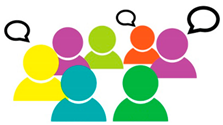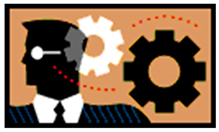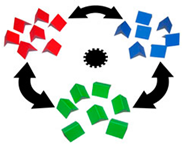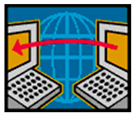Enhancing Skills for Employment in the Workplace of the Future 2020 Using the Theory of Connectivity: Shared and Adaptive Personal Learning Environments in a Spanish Context
Abstract
:1. Introduction
1.1. Background
- Smart economy (e-business, e-commerce): increase in productivity thanks to ICT, advanced industry, innovation, provision of services, new products/services/business models and entrepreneurship.
- Smart environment: Smart energy (renewable, smart grids, metering), control and monitoring of pollution, renovation of buildings and services, green buildings, green urban planning, efficient use of resources, street lighting, waste management, drainage systems and management of monitored water resources.
- Smart government: transparency, Open Data, e-government, participatory decision making, co-created e-Services.
- Smart living: lifestyle/behaviour/consumption based on ICT, healthy and safe living in a city that vibrates with culture, good quality housing and accommodation, high levels of social cohesion.
- Smart mobility: ICT-based integrated transport, logistic systems, clean transport options (non-motorised), real-time information, user-provided data to improve the system.
- Smart people: e-skills, ICT related work, access to education and training, inclusive, creative and innovative society to introduce, use, manipulate and personalise data, decision making and creation of products and services.
1.2. Literature Review
- Skill of creating meaning, or ability to determine the deeper meaning or significance of what is expressed.
- Skill of social intelligence, or ability to connect with others in a deep and direct way in order to feel and stimulate desired reactions and interactions.
- Skill of original and adaptive thought, with regards to the sufficiency of thought and appearance of solutions and answers beyond that which is routine or based on norms.
- Skill of trans-cultural competence, or ability to operate in different cultural contexts.
- Skill of computational thinking for transferring large quantities of data into abstract concepts and for understanding data-based reasoning.
- Skill of literacy in new means of communication in order to critically evaluate and develop content used by new means of communication, and to leverage these means for persuasive communication.
- Skill of transdisciplinarity for understanding concepts through multiple disciplines.
- Skill of developing a way of thinking in order to represent and develop work tasks and processes for the desired results.
- Skill of cognitive load management or ability to discriminate and filter information according to the order of importance and to understand how to take full advantage of cognitive functioning via a variety of tools and techniques.
- Skill of virtual collaboration in order to work productively, guide management and demonstrate presence as a member of a virtual team.
- H1: The degree of acquisition of Future Work Skills in the Smart City is linked with the schooling situation, incorporation within the workforce of the young person and the educational level.
- O1: To develop, validate and apply a descriptive scale to the estimation of the Future Skills of the Smart City within adolescent UFMs.
- O2: To evaluate the level of skill acquisition for the working future of UFMs who find themselves in cities in the South of Europe.
- O3: To analyse the degree of Future Work Skill acquisition in each one of the participating groups as a function of the variables: schooling, work experience and educational level.
2. Materials and Methods
2.1. Design and Participants
- Schooling: schooled/not schooled, according to schooling levels of this population in the Spanish Educational System.
- Self-reported highest level of qualification (curricular competence): Primary Education/Compulsory Secondary Education/Bachelor’s degree/Professional Training, according to levels provided in previous reports by Reception Centres.
- Labour activity: Some labour activity/without any labour activity. Considering any type of working activity or experiences, even that which is discontinuous in nature and without regulated economic payment. Although it is illegal for children under 16 years of age to work in the European context, UFMs from countries outside the EU usually have had irregular and intermittent work experiences from an earlier age of eleven years.
2.2. Measure
2.3. Data Analysis
3. Results
4. Discussion and Conclusions
- Skill of making sense → Appropriate and continuous training: In some way, we can say that these two skills have a certain degree of similarity, in that they require experiences and continuous training in order to facilitate strategy development or the production of solutions.
- Social intelligence skills → Working in a team: These may be related in that in order to conduct optimal working within a team, individuals have to effectively interact with others.
- Novel and adaptive thinking skills → Added value: These both show characteristics that relate to the effectiveness and ease of tackling problems that can arise when entering a new or unknown environment. It is because of this that individuals not only have to deal with that which is known to them, but also the unknown.
- Cultural skills → International experience: These coincide in the fact that having studied or worked in a foreign country can be a key factor at the time of developing cultural skills. In this way, the need arises to acquire and deepen transcultural competencies. In other words, those skills that enable individuals to operate with a certain fluency in unknown cultural contexts that are distant from their own.
- Competence 1—Linguistic; use of language as an instrument of oral and written communication, as much in the Spanish language as the foreign tongue. Command of language brings with it the ability to convey messages for a rigorous understanding that matches what the person or author of this message wants to say. This gives the most objective interpretation possible so that the true meaning can be deciphered.
- Competence 7—Learn to learn (cognitive skills); learning strategies: attention, comprehension, memory, perception, thought processing (observation, analysis, classification, representation, interpretation and evaluation).
- Competence 8—Autonomy and personal initiative; becoming conscious of one’s knowledge, competencies and environment, and being able to act on/within them; being able to discover opportunities, putting personal projects into action and participating in group projects; finally, provides help to the individual to find their place in the world.
- Basic competencies: (2) mathematical reasoning, (4) treatment of information and digital competence.
- Capacity to investigate information from different sources and critically compare it before arriving at an interpretation.
- Computer knowledge (digital competencies).
- Leadership capacity.
- Capacity to investigate information from different sources and critically compare it before arriving at an interpretation (digital competence).
- Command of social skills: interpersonal relationships (social competence).
- Command of skills for effective communication: active listening, empathy and assertiveness.
- Efficient communication skills: active listening, empathy, assertiveness.
- Social skills.
- Social values.
- Curiosity for knowing other cultures.
- Adaptation skills.
- Desire to travel.
- Resolution capacity.
- Cooperative working skills.
- Leadership capacity.
Author Contributions
Funding
Conflicts of Interest
Appendix A
| Skill Making Sense | Rating Scale | Description |
|---|---|---|
| Description: Ability to determine the deep meaning or significance of what is being expressed.  | 20–18 | I have explanatory clarity at the time of presenting my topic; every now and then I give examples so that the explication is better understood; I am even able to compare with theory and go back to the central topic, maintaining appropriate composure and raising questions to address possible doubts. |
| 17–14 | I am focused on my topic and I communicate well but I do not give examples. | |
| 13–11 | Every now and then I have to look at some notes to keep control of my topic and be able to follow the presentation well. | |
| 10–00 | I do not understand what I am presenting, for this reason I always have to read, being incapable of giving my own examples and not being focused on the topic. |
| Skill | Rating Scale | Description |
|---|---|---|
| Social intelligence: Ability to connect with others in a deep and direct way, to perceive and stimulate the desired reactions and interactions.  | 20–18 | I urge them to reconsider the consequences of their unjustified absence in class and their consideration of the pertinence of taking my notes. I propose that it is a lack of respect towards the rest of the classmates. |
| 17–14 | I lend them the notes but I tell them that the next time I will not do it, given that it is not ok to take advantage of the efforts of others without having a stronger reason. | |
| 13–11 | I lend them the notes although I do not want to; I do not like that others take advantage of my work. | |
| 10–00 | I do not lend them the notes because they do not deserve them. It’s every man for himself. |
| Skill | Rating Scale | Description |
|---|---|---|
| Novel and adaptive thinking: Ability to think and form responses beyond that which is purely memorised or based on norms.  | 20–18 | I am capable of keeping up with the pace of the class even without having the theory. For this reason, I answer with ease and with a great capacity of imagination. |
| 17–14 | I give the most appropriate answer possible and I attempt to handle the topic with the knowledge I already have. | |
| 13–11 | I try to give an answer even when I know that it does not address the proposed question. | |
| 10–00 | I do not know how to answer because, without having the theory, I do not feel at ease and I am not able to give a creative answer, nor to carry the topic forward. |
| Skill | Rating Scale | Description |
|---|---|---|
| Cultural: Ability to operate in different cultures  | 20–18 | I have no problem because I would want them to accept me too, besides in this way I can learn a little bit about their culture and language and can get a collaborative piece of work out of it. |
| 17–14 | The idea pleases me, however I think that it would be too costly to my time to complete the work. | |
| 13–11 | I tell them that I am not very convinced because I think that their culture and language is not going to facilitate the work. In the end it’s possible that we will not adapt. | |
| 10–00 | I would say no because we do not speak the same language and I do not understand their culture, for this reason it would be much more difficult to complete the work and we would not end up adapting. |
| Skill | Rating Scale | Description |
|---|---|---|
| Computational thinking: Ability to translate immense quantities of data into abstract concepts and to understand the reasoning based on large volumes of information.  | 20–18 | I locate keywords in order to conduct a general Internet search, from the first readings I make my outline and I delve deeper into the relevant points in order to inter-relate them. |
| 17–14 | I know what I want to search for and afterwards I go summarising and ordering. | |
| 13–11 | First I search all of the information and then I go ordering according to points or themes. | |
| 10–00 | I start to search for information on the Internet and I go writing everything that occurs to me. I then organise the content at the end. |
| Skill | Rating Scale | Description |
|---|---|---|
| Command of new media: Ability to critically evaluate and develop content that is used by new media and build up this media for persuasive communication.  | 20–18 | I urge my classmates for us to organise ourselves. I desire that the final work has the coherence and cohesion that it should have, for this reason I propose to them that we use the same programs and the same sources. |
| 17–14 | I suggest that we could work with program X in order to organise and share information in real-time, but my idea does not go ahead because the majority prefer to follow a more traditional method. | |
| 13–11 | I do the part that they have given me and I ask about the doubts that I have; I present it as and when my classmates tell me to. | |
| 10–00 | I limit myself to do the part that I am given, trying to meet the deadlines they have given me. |
| Skill | Rating Scale | Description |
|---|---|---|
| Integration of disciplines: Knowledge and ability for understanding concepts through multiple disciplines.  | 20–18 | I would be capable of introducing the data into a computer program and would even be able to analyse the information. |
| 17–14 | I insert the data into a computer program, but I would find it difficult to analyse the information. | |
| 13–11 | I would only be able to introduce the data into a computer program. | |
| 10–00 | I would not be able to manage with any computer program, better with paper. |
| Skill | Rating Scale | Description |
|---|---|---|
| Design mentality: Ability to present and develop work tasks and processes in order to achieve the desired results.  | 20–18 | I go to the tutorial with all of my information and the most interesting points ordered, and above all with possible doubts well outlined so that everything is clearer. |
| 17–14 | I introduce all of the collected information in an ordered fashion, but not according to themes and without knowing well where each bit fits best. | |
| 13–11 | I introduce all of the information but only halfway, given that there are parts that I know how to organise and others that I do not. | |
| 10–00 | I do not know how to organise this information and so I present everything I have without any established outline. |
| Skill | Rating Scale | Description |
|---|---|---|
| Intellect management: Ability to discriminate between and filter relevant information, and to understand how to maximise comprehension.  | 20–18 | I am capable of searching within diverse sources and filtering only that information that is most relevant for my work, in this way having greater clarity and specificity. |
| 17–14 | I perform a search of different sources but I am not capable of filtering to get to only the relevant information. | |
| 13–11 | I search within only a few sources and I collect everything I find that speaks to or has something to do with my topic. | |
| 10–00 | I put all of the information that I have found, even that which has little to do with the topic of my work in order to get maximum comprehension. |
| Skill | Rating Scale | Description |
|---|---|---|
| Virtual collaboration: Ability to work productively, to provoke involvement and to demonstrate presence as a member of a virtual team.  | 20–18 | The idea of comparing information relating to my work in a virtual way excites me and I have no problem communicating through the Internet. |
| 17–14 | I do not mind doing it because I am used to handling New Technologies, however I would prefer to do it face-to-face. | |
| 13–11 | It does not please me to do distance working because it is more difficult to work via digital communication. | |
| 10–00 | I consider that in order to complete a good piece of work as a team we should be physically present; virtual communication is not a good resource for carrying out a good piece of work. |
References
- William, J.M. Urban Life, Jim–But Not as We Know It; The MIT-Press: Cambridge, MA, USA, 2000. [Google Scholar]
- Lei, T.; Tang, Y. Digital Governance Model for Big Data Era—Based on Typical Practices in Singapore. Hum. Soc. Sci. 2019, 7, 76–82. [Google Scholar] [CrossRef]
- Ahvenniemi, H.; Huovila, A.; Pinto-Seppä, I.; Airaksinen, M. What are the differences between sustainable and smart cities? Cities 2017, 60, 234–245. [Google Scholar] [CrossRef]
- Tran, T.T. Is graduate employability the whole-of-higher-education-issue? J. Educ. Work 2015, 28, 207–227. [Google Scholar] [CrossRef]
- Aldieri, L.; Vinci, C.P. Innovation effects on employment in high-tech and low-tech industries: Evidence from large international firms within the triad. Eurasian Bus. Rev. 2018, 8, 229–243. [Google Scholar] [CrossRef]
- Domínguez, M.; Crespi, M. Smart cities. Who are the cities we are designing for? Tecmared, II Congress of Smart Cities, Madrid (Spain). 2015. Available online: https://www.esmartcity.es/comunicaciones/i-congreso-ciudades-inteligentes-diseno-ciudades (accessed on 3 August 2019).
- Albino, V.; Berardi, U.; Dangelico, R.M. Smart cities: Definitions, dimensions, performance, and initiatives. J. Urban Technol. 2015, 22, 3–21. [Google Scholar] [CrossRef]
- Olmedo-Moreno, E.; Delgado-López, A. From Smart Cities to Smart Human Cities: Digital inclusion in App’s. Rev. Fuentes 2015, 17, 41–65. [Google Scholar] [CrossRef]
- Galgóczi, B.; Leschke, J. EU Labour Migration in Troubled Times: Skills Mismatch, Return and Policy Responses; Routledge: New York, NY, USA, 2016. [Google Scholar]
- Borjas, G.J.; Monras, J. The labour market consequences of refugee supply shocks. Econ. Pol. 2017, 32, 361–413. [Google Scholar] [CrossRef] [Green Version]
- Bakhshi, H.; Downing, J.M.; Osborne, M.A.; Schneider, P. The Future of Skills: Employment in 2030; Pearson: London, UK, 2017. [Google Scholar]
- Davies, A.; Fidler, D.; Gorbis, M. Future Work Skills 2020; Institute for the Future for the University of Phoenix Research Institute: Palo Alto, CA, USA, 2011. [Google Scholar]
- Gilbert, N. Complexity at the social science interface. Complexity 2014, 19, 1–4. [Google Scholar] [CrossRef] [Green Version]
- Santamaría, F. Evolución y desarrollo de un Entorno Personal de Aprendizaje en la Universidad de León. Dig. Educ. Rev. 2010, 18, 48–60. [Google Scholar]
- Hyttinen, K.; Ruoslahti, H.; Jokela, J. Model for Effective Integration between Research, Work Life and Higher Education in International Security Studies. In Proceedings of the 9th International Joint Conference on Knowledge Discovery, Knowledge Engineering and Knowledge Management, Funchal, Portugal, 1–3 November 2017; pp. 299–306. [Google Scholar] [CrossRef]
- Kivunja, C. Teaching students to learn and to work well with 21st century skills: Unpacking the career and life skills domain of the new learning paradigm. Int. J. High. Educ. 2015, 4, 1–11. [Google Scholar] [CrossRef]
- Rania, N.; Migliorini, L.; Sclavo, E.; Cardinali, P.; Lotti, A. Unaccompanied migrant adolescents in the Italian context: Tailored educational interventions and acculturation stress. Child Youth Serv. 2014, 35, 292–315. [Google Scholar] [CrossRef]
- Keles, S.; Friborg, O.; Idsøe, T.; Sirin, S.; Oppedal, B. Depression among unaccompanied minor refugees: The relative contribution of general and acculturation-specific daily hassles. Ethn. Health 2016, 21, 300–317. [Google Scholar] [CrossRef] [PubMed]
- Van Roy, V.; Vertesy, D.; Vivarelli, M. Technology and employment: Mass unemployment or job creation? Empirical evidence from European patenting firms. Res. Policy 2018, 47, 1762–1776. [Google Scholar] [CrossRef]
- Martínez-Clares, P.; González-Lorente, C. Personal and Interpersonal Competencies of University Students Entering the Workforce: Validation of a Scale. RELIEVE 2019, 25, 1–18. [Google Scholar] [CrossRef]
- O’Higgins, A.; Ott, E.M.; Shea, M.W. What is the impact of placement type on educational and health outcomes of unaccompanied refugee minors? A systematic review of the evidence. Clin. Child Fam. Psychol. Rev. 2018, 21, 354–365. [Google Scholar] [CrossRef] [PubMed]
- Jarvis, C.B.; Mackenizie, S.B.; Podsakoff, P.M. The Problem of Measurement Model Misspecification in Behavioral and Organizational Research and Some Recommended Solutions. J. Appl. Psychol. 2005, 90, 710–730. [Google Scholar] [CrossRef]
- Page Executive. The 10 Competences Most Demanded by Companies in the Spanish Labour Market; Page Executive: Madrid, Spain, 2016; Available online: http://www.michaelpage.es/sites/michaelpage.es/files/17_05_2016.pdf (accessed on 6 May 2019).
- Barbulescu, R.; Grugel, J. Unaccompanied minors, migration control and human rights at the EU’s southern border: The role and limits of civil society activism. Migr. Stud. 2016, 4, 253–272. [Google Scholar] [CrossRef]
- The Organisation for Economic Co-operation and Development (OECD). Measurement of Student Knowledge and Skills. A New Frame of Reference for Evaluation; OCDE: Pairs, France, 1999. [Google Scholar]
- OECD. Panorama of the Society 2014 Key Results: SPAIN the Crisis and Its Consequences; OCDE: Madrid, Spain, 2014; Available online: http://www.oecd.org/spain/OECD-SocietyAtaGlance2014-Highlights-Spain.pdf (accessed on 17 May 2019).
- ASEM-LLL-Hub. Meeting Asia-Europe. Copenhagen, Denmark; ASEM-LLL-Hub: Zug, Switzerland, 2016; Available online: http://www.asia-europe-institute.org/ASEM-LifeLong-Learning/lllcontent.html (accessed on 17 May 2019).
- Assiter, A. Transferable Skills in Higher Education; Routledge: London, UK, 2017. [Google Scholar]
- WCEFA. Satisfaction of the Basic Needs of Learning; WCEFA: Jomtien, Tailandia, 1990; Available online: http://www.unesco.org/education/pdf/JOMTIE_S.PDF (accessed on 18 June 2019).
- World Meeting for Children Report; Woodhead Publishing: Cambridge, UK, 1990.
- World Bank Report. World Development Indicators 2005; World Bank: Washington, DC, USA, 2005; Available online: http://documents.worldbank.org/curated/en/947951468140975423/World-development-indicators-2005 (accessed on 24 July 2019).
- Mourshed, M.; Farrell, D.; Barton, D. Education to Employment: Designing a System that Works; McKinsey Center for Government: Boston, MA, USA, 2013. [Google Scholar]
- Cassidy, S. Developing employability skills: Peer assessment in higher education. Educ. Train. 2006, 48, 508–517. [Google Scholar] [CrossRef]
- Wilton, N. Do employability skills really matter in the UK graduate labour market? The case of business and management graduates. Work Employ. Soc. 2011, 25, 85–100. [Google Scholar] [CrossRef]
- United Cities and Local Governments (UCLG). Smart City Studies: International Study on the Situation of ICT, Innovation and Knowledge in Cities. Bilbao; UCLG: Barcelona, Spain, 2012; Available online: http://www.socinfo.es/contenido/seminarios/1404smartcities6/04BilbaoSmartcitiesstudy_es2012.pdf (accessed on 18 July 2019).
- Siemens, G. Connectivism: A Learning Theory for the Digital Age. Available online: http://www.itdl.org/journal/jan_05/article01.htm (accessed on 5 August 2019).
- Cope, B.; Kalantzis, M.; Magee, L. Towards a Semantic Web: Connecting Knowledge in Academic Research; Chandos Publishing: Cambridge, UK, 2011. [Google Scholar]
- Cobo, C.Y.; Moravec, J. The Invisible Learning. Towards a New Ecology of Education; Ediciones de la Universitat de Barcelona: Barcelona, Spain, 2011. [Google Scholar]
| Variables and Levels | Frequency | Percentage | Valid Percentage | |
|---|---|---|---|---|
| Schooling | Schooled | 18 | 5.2 | 5.2 |
| Not schooled | 327 | 94.8 | 94.8 | |
| Highest qualification achieved | Primary | 119 | 34.5 | 34.5 |
| Compulsory Secondary | 119 | 34.5 | 34.5 | |
| Bachelor’s | 19 | 5.5 | 5.5 | |
| Professional Training | 88 | 25.5 | 25.5 | |
| Self-reported labour activity | With experience | 137 | 39.7 | 39.7 |
| Without experience | 207 | 60.0 | 60.0 | |
| Skills | Scores | |||||||
|---|---|---|---|---|---|---|---|---|
| N | 0–10 a | 11–13 b | 14–17 c | 18–20 d | Median | Standard Deviation | Variance | |
| FWS 1 To make sense | 344 | 100 | 111 | 80 | 53 | 14.11 | 3.617 | 13.084 |
| FWS 2 Social intelligence | 343 | 132 | 106 | 62 | 43 | 13.45 | 3.512 | 12.336 |
| FWS 3 Novel and adaptive thinking | 344 | 93 | 114 | 93 | 44 | 14.17 | 3.421 | 11.701 |
| FWS 4 Cultural skills | 344 | 180 | 43 | 50 | 71 | 13.46 | 4.122 | 16.989 |
| FWS 5 Computational thinking | 344 | 114 | 85 | 72 | 73 | 14.33 | 3.874 | 15.008 |
| FWS 6 Command of new media | 344 | 146 | 89 | 70 | 39 | 13.33 | 3.543 | 12.556 |
| FWS 7 Integration of disciplines | 344 | 143 | 84 | 57 | 60 | 13.64 | 3.818 | 14.576 |
| FWS 8 Design mentality | 344 | 161 | 88 | 60 | 35 | 13.01 | 3.467 | 12.023 |
| FWS 9 Intellect management | 344 | 165 | 82 | 63 | 34 | 12.99 | 3.482 | 12.125 |
| FWS 10 Virtual collaboration | 344 | 148 | 68 | 48 | 80 | 13.90 | 4.092 | 16.747 |
| Skills (FWS) | Sum of Squares | df | Squared Mean | F | Sig. | |
|---|---|---|---|---|---|---|
| FWS 3 Novel and adaptive thinking | Inter-groups | 108.306 | 1 | 108.306 | 9.485 | 0.002 |
| Intra-groups | 3905.249 | 342 | 11.419 | |||
| Total | 4013.555 | 343 | ||||
| FWS 5 Computational thinking | Inter-groups | 118.252 | 1 | 118.252 | 8.041 | 0.005 |
| Intra-groups | 5029.629 | 342 | 14.707 | |||
| Total | 5147.881 | 343 | ||||
| FWS 6 Command of new media | Inter-groups | 93.879 | 1 | 93.879 | 7.621 | 0.006 |
| Intra-groups | 4212.677 | 342 | 12.318 | |||
| Total | 4306.555 | 343 | ||||
| FWS 7 Integration of disciplines | Inter-groups | 73.710 | 1 | 73.710 | 5.118 | 0.024 |
| Intra-groups | 4925.868 | 342 | 14.403 | |||
| Total | 4999.578 | 343 | ||||
| Intra-groups | 4128.617 | 342 | 12.072 | |||
| Total | 4158.927 | 343 | ||||
| FWS 10 Virtual collaboration | Inter-groups | 80.760 | 1 | 80.760 | 4.877 | 0.028 |
| Intra-groups | 5663.472 | 342 | 16.560 | |||
| Total | 5744.233 | 343 | ||||
| Skills (FWS) | Sum of Squares | df | Squared Mean | F | Sig. | |
|---|---|---|---|---|---|---|
| FWS 5 Computational thinking | Inter-groups | 133.636 | 3 | 44.545 | 3.020 | 0.030 |
| Intra-groups | 5014.244 | 340 | 14.748 | |||
| Total | 5147.881 | 343 | ||||
| FWS 6 Command of new media | Inter-groups | 101.275 | 3 | 33.758 | 2.729 | 0.044 |
| Intra-groups | 4205.280 | 340 | 12.368 | |||
| Total | 4306.555 | 343 | ||||
| FWS 7 Integration of disciplines | Inter-groups | 202.873 | 3 | 67.624 | 4.793 | 0.003 |
| Intra-groups | 4796.705 | 340 | 14.108 | |||
| Total | 4999.578 | 343 | ||||
| Skill | Sum of Squares | df | Squared Mean | F | Sig. | |
|---|---|---|---|---|---|---|
| FWS 4 Cultural skills | Inter-groups | 121.849 | 2 | 60.925 | 3.641 | 0.027 |
| Intra-groups | 5705.496 | 341 | 16.732 | |||
| Total | 5827.346 | 343 | ||||
| FWS 9 Intellect management | Inter-groups | 78.930 | 2 | 39.465 | 3.298 | 0.038 |
| Intra-groups | 4079.997 | 341 | 11.965 | |||
| Total | 4158.927 | 343 | ||||
| Variable | Level (*) Group with higher mean values in the indicated skills | Skills | |||||||||
| FWS 1: To make sense FWS2: Social intelligence FWS3: Novel and adaptive thinking FWS4: Cultural skills FWS5: Computational thinking | FWS 6: Command of new media FWS 7: Integration of disciplines FWS 8: Design mentality FWS 9: Intellect management FWS 10: Virtual collaboration | ||||||||||
| 1 | 2 | 3 | 4 | 5 | 6 | 7 | 8 | 9 | 10 | ||
| Schooling | Schooled */not schooled | X | X | X | X | X | |||||
| Self-reported curricular competence curricular | Primary/Secondary education/Bachelor degree/Professional training. | X | X | X | |||||||
| Labour activity | With some labour activity */without any labour activity. | X | X | ||||||||
© 2019 by the authors. Licensee MDPI, Basel, Switzerland. This article is an open access article distributed under the terms and conditions of the Creative Commons Attribution (CC BY) license (http://creativecommons.org/licenses/by/4.0/).
Share and Cite
Expósito López, J.; Romero-Díaz de la Guardia, J.J.; Olmos-Gómez, M.d.C.; Chacón-Cuberos, R.; Olmedo-Moreno, E.M. Enhancing Skills for Employment in the Workplace of the Future 2020 Using the Theory of Connectivity: Shared and Adaptive Personal Learning Environments in a Spanish Context. Sustainability 2019, 11, 4219. https://doi.org/10.3390/su11154219
Expósito López J, Romero-Díaz de la Guardia JJ, Olmos-Gómez MdC, Chacón-Cuberos R, Olmedo-Moreno EM. Enhancing Skills for Employment in the Workplace of the Future 2020 Using the Theory of Connectivity: Shared and Adaptive Personal Learning Environments in a Spanish Context. Sustainability. 2019; 11(15):4219. https://doi.org/10.3390/su11154219
Chicago/Turabian StyleExpósito López, Jorge, José Javier Romero-Díaz de la Guardia, María del Carmen Olmos-Gómez, Ramón Chacón-Cuberos, and Eva María Olmedo-Moreno. 2019. "Enhancing Skills for Employment in the Workplace of the Future 2020 Using the Theory of Connectivity: Shared and Adaptive Personal Learning Environments in a Spanish Context" Sustainability 11, no. 15: 4219. https://doi.org/10.3390/su11154219
APA StyleExpósito López, J., Romero-Díaz de la Guardia, J. J., Olmos-Gómez, M. d. C., Chacón-Cuberos, R., & Olmedo-Moreno, E. M. (2019). Enhancing Skills for Employment in the Workplace of the Future 2020 Using the Theory of Connectivity: Shared and Adaptive Personal Learning Environments in a Spanish Context. Sustainability, 11(15), 4219. https://doi.org/10.3390/su11154219







